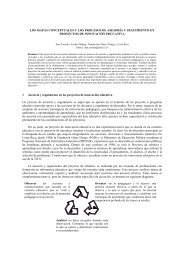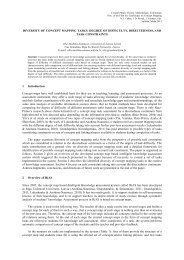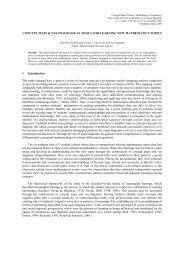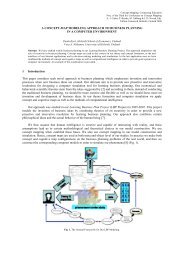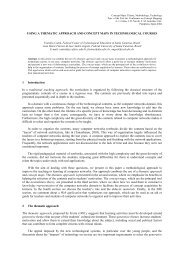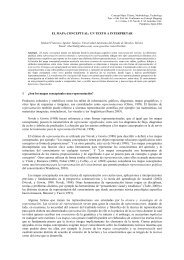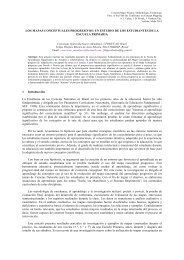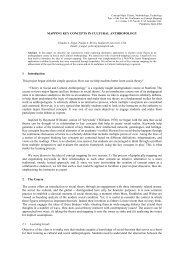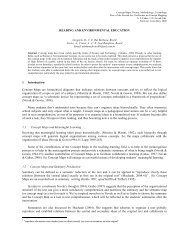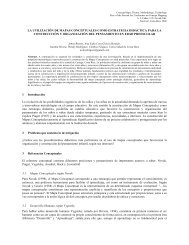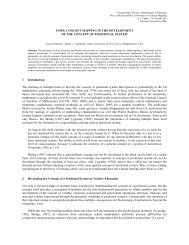CMAP LINKING PHRASE CONSTRAINT FOR THE STRUCTURAL ...
CMAP LINKING PHRASE CONSTRAINT FOR THE STRUCTURAL ...
CMAP LINKING PHRASE CONSTRAINT FOR THE STRUCTURAL ...
Create successful ePaper yourself
Turn your PDF publications into a flip-book with our unique Google optimized e-Paper software.
2.2 Design decision 2: text genre for analysis samplesThe most appropriate choices of text sample sources for learner analysis are published technical research papersand articles from popular science magazines and newspapers. Magazine articles were chosen for the followingreasons.a. As well as information report genre (impersonal, rhetorically distant, highly formulaic) language, theyalso contain persuasive and motivating language, while technical research papers by conventioncontain only report genre. It is essential for this task array that the learners confront mixed genre text.b. The somewhat loose structure of popular science articles, where knowledge structure information isoften mixed with argument structure information, is more similar to the structure of L2 TAW learners'assemblages of ideas than to that of research papers.c. The register of popular science writing shares many lexical and discourse features with that used in thespoken language of technical academic conference presentations.2.3 Design decision 3: the array of linking phrasesIn the guidance of learner analysis of text with Cmaps, the following rules force the learners to separatepersuasion from essential content, and to construct dyads whose English equivalents are concise, logicalargument utterances. Based on informal, exploratory observation of learner behavior over a one-year period, thefollowing rules appear sufficient.1. Nodes must not contain rhetorical devices; those reside in the linking phrases.2. Nodes must contain nouns/noun phrases/knowledge structures.3. Relations between nodes must be in the task creator's defined list of allowable TAW relations.To determine the list of TAW-allowable 'relations' for Cmap linking phrases, it is necessary to examinenumerous samples of TAW argument. This work is under way now, and the following are tentative observations.The relations used in Horn's (2001) argument mapping are claims, rebuttals and counterrebuttals; thesewere found to be inadequate for representing the detailed unilateral arguments commonly found in popularscience articles. On the other hand, Mann's (1999) RST relations are extensive, being designed to meet the needsof representation of humanities advocative-adversarial discourse, and are too rich to (a) represent elegantly thecontrolled argument format of the research paper genre or (b) serve as low cognitive load tools for secondlanguage TAW writers.A trial and error approach was taken: over a period of one year, instructor-learner negotiation of summarycompleteness and quality yielded the following list of linking phrases necessary for the mapping of theunilateral argument in technical research papers. The resulting array of necessary and allowable linking phrasesis shown in Figure 3.Citation as subject Results as subject Claim as subjectclaims (that)proposes (that)implies (that)suggests (that)infers (that)observes (that)reveals (that)demonstrates (that)indicates (that) disprovesdisprovesproves (that)implies (that)is supported byis contradicted byis in agreement withis in opposition toassumes (that)Figure 3. Allowable linking phrases for the argument mapping task2.4 Negotiating map contentsInstructional design deliberations led to the selection of the constructivist approach (Jonassen et al. 2006) formap-based TAW instruction. In this constructivist approach, the learners analyze sample texts and reflectcollaboratively to arrive at consensus. By presenting various frameworks for analysis, the instructor can directthe learners’ analytical process towards a focus on argument relations and register characterizations.




